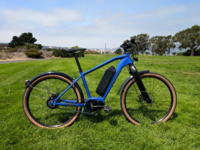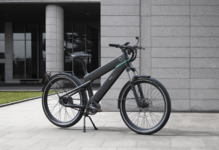Asher
Well-Known Member
I'm resurrecting this thread to document the apple of my eye, Class 3 commuter e-bikes. Thankfully, since the thread was posted, there's been a lot of new models in this category, though still nothing quite at the $2k mark that's fully loaded with a torque sensor, with an integrated battery (Juiced CCX and Ride1Up LMTD come close). Hopefully, that niche will be filled soon by the Zen Shakti and Ride1Up Prodigy. (Also, a lot of the bikes below require Bosch or other OEM batteries which are rather costly to replace - think of inkjet printer cartridges.)
Requirements: e-bike is a full size, non-folding frame capable of reaching 21+ mph, has flat bars, slick tires, rack and fender mounts. Ideally it comes with fenders, rack, integrated lighting, integrated battery with 500+ wh, in multiple sizes. No fatbikes.
Cannondale Canvas Neo - ~$4k

Electra Cafe Moto Go!

Priority Current - $2600+

Dost Kope/Drop - $2800

Specialized Turbo Vado/Vado SL, $3.25k+

Gazelle Medeo T10+ HMB - $3500

Bulls Urban 10 EVO - $4k

Ride1Up, Multiple models, $1k+

Giant Transend/Fastroad/Explore et al, $2850-4000


Trek Allant 8S+

Juiced CCS/CCX $1900+

Aventon Level - $1600 (and other models); Level appears to be the same frame as Ride1Up 700

Karmic Koben S $3.5k

Fuell Flluid $4k

*Does not include fatbikes or single speeds.
Original Post:
Despite the abundance of ebike brands, it's hard to find Class 3, 750+ W commuter models. Why are brands so uninterested in this type? Radpower has a city model that's 750 W but still only Class 2, for example. Then there are Bosch mid drives that are only 350 W. There are a couple fatbike options, like from Biktrix and Juiced, but a fatbike IMO has some tradeoffs vs a nice balloon tires option like a 27.5 x 2.4" size.
I have a Juiced commuter, and for most American cities where you can't always avoid mixing with cars, the higher speed is a godsend, and more power means a better chance of accelerating past the cars. (I wish Juiced would make a higher power model, classed as a moped, in fact, in California anyhow.)
Requirements: e-bike is a full size, non-folding frame capable of reaching 21+ mph, has flat bars, slick tires, rack and fender mounts. Ideally it comes with fenders, rack, integrated lighting, integrated battery with 500+ wh, in multiple sizes. No fatbikes.
Cannondale Canvas Neo - ~$4k
Electra Cafe Moto Go!
Priority Current - $2600+
Dost Kope/Drop - $2800
Specialized Turbo Vado/Vado SL, $3.25k+
Gazelle Medeo T10+ HMB - $3500
Bulls Urban 10 EVO - $4k
Ride1Up, Multiple models, $1k+
Giant Transend/Fastroad/Explore et al, $2850-4000
Trek Allant 8S+
Juiced CCS/CCX $1900+
Aventon Level - $1600 (and other models); Level appears to be the same frame as Ride1Up 700
Karmic Koben S $3.5k
Fuell Flluid $4k
*Does not include fatbikes or single speeds.
Original Post:
Despite the abundance of ebike brands, it's hard to find Class 3, 750+ W commuter models. Why are brands so uninterested in this type? Radpower has a city model that's 750 W but still only Class 2, for example. Then there are Bosch mid drives that are only 350 W. There are a couple fatbike options, like from Biktrix and Juiced, but a fatbike IMO has some tradeoffs vs a nice balloon tires option like a 27.5 x 2.4" size.
I have a Juiced commuter, and for most American cities where you can't always avoid mixing with cars, the higher speed is a godsend, and more power means a better chance of accelerating past the cars. (I wish Juiced would make a higher power model, classed as a moped, in fact, in California anyhow.)
Attachments
Last edited:


